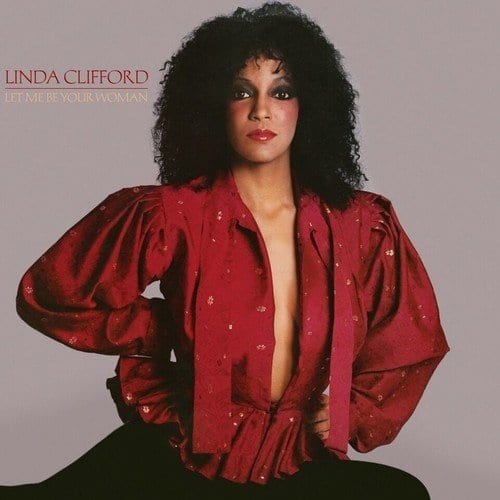



Like many R&B stalwarts of the late ’60s and early ’70s, Curtis Mayfield got knocked for a loop by disco. The kind of provocative music he’d made a few years earlier, best represented by the Superfly soundtrack, was by 1976-77 no longer in vogue, and his music hadn’t kept pace with an audience already moving past those heady times. Further, the label he’d started to distribute his music and that of others, Curtom, was no longer scoring any hits.
Fortunately, disco threw him a lifeline, by the name of Linda Clifford.
In just three years, 1977-80, Clifford recorded four albums for Curtom – If My Friends Could See Me Now, Let Me Be Your Woman, Here’s My Love, and I’m Yours – that bridged from disco’s heyday to the first life-after-disco steps for its former stars. That Clifford was around long enough to record that many records, when most folks might remember her for one or two tracks at best, is something of a news flash. Those records, now reissued by Blixa Sounds, show what made her a cult-fave disco diva. They also show the pivot from disco divadom to the next phase was as unforgiving for Clifford as the evolution of black pop into disco had been for Mayfield a few years earlier.
Mayfield associate Marv Stuart happened upon Clifford singing in a Chicago lounge in the mid-’70s and brought her into the Curtom fold. After her first album went nowhere, Mayfield brought in Gil Askey, a veteran Motown producer/arranger. The impact was immediate: If My Friends… would turn out to be Clifford’s biggest hit. The title cut, already something of a standard from the ’60s musical Sweet Charity, might have been just another disco novelty cover, but Clifford (who had performed in the film version of the musical) brought some passion to it, and sold it well enough to reach the top of the dance charts. Today, however, the better known If My Friends… track among disco crate diggers is “Runaway Love”, a sassy rejoinder to an unfaithful lover that still sounds fresh 40 years later.
Mayfield attempted to strike while the iron was freshly hot by recording some duet singles, “Between You Baby and Me” and “Love’s Sweet Sensation”, and mounting a duet tour with her, but Mayfield’s prior hit-making touch did not come through this time. Similarly, Clifford’s three follow-up albums after If My Friends… barely made a dent, despite more than solid singing from Clifford and production from Askey and others. Clifford tried to go to the let’s-discofy-a-standard well once too often with her version of “Bridge Over Troubled Water” on Let Me Be Your Woman (1979), which nowadays sounds like something from the fringes of a forgotten disco time capsule.
Here’s My Love find Curtom already trying to establish Clifford as more than just a disco singer, but the material doesn’t rise to the occasion; Clifford frankly sounded more like a legacy act than someone on the pulse of black pop. Her best album from the Curtom years, I’m Yours (1980), features Isaac Hayes handling the production duties (except “Red Light”, a secondary hit from the Fame soundtrack tacked onto the album). It’s an overall solid effort, but Hayes, like Mayfield, wasn’t able to transition into a new black pop era, and the record generated little heat.
It didn’t help matters that the Curtom brand had been floundering for quite some time. By the time Clifford came on board, many of the label’s key acts – including the Impressions, Mayfield’s former band – weren’t around anymore. The label shifted from being distributed by Buddha to Warner Brothers, but that didn’t help matters. During Clifford’s time, the label got picked up by RSO Records, flush with cash from the Bee Gees and the Saturday Night Fever and Grease soundtracks, but they couldn’t break Clifford beyond the disco niche either.
Stronger material might have been able to carry her into the ’80s adult r&b market, alongside Phyllis Hyman and Anita Baker, but that was not to be. A stronger push from the parent label might also have helped, but RSO collapsed, and Clifford would soon leave Curtom, never again to enjoy the chart-topping success of her early work.
So does that mean her career was a flop? Not at all. She easily handled a full range of material, even if there’s nothing you can point to that would mark her as particularly unique. She rode Askey’s productions most confidently, and their best work together was more than a cut above disco schlock. Even her more obscure albums have good moments on them (although a smartly curated compilation might have made a better case than releasing all four albums as a whole). And she’s still around, enjoying her life-after-life-after-disco moment as a venerated diva. If anything, these reissues show Clifford deserving of a better fate than being known as just a one-hit wonder, from an era where there were tons of them.


![Call for Papers: All Things Reconsidered [MUSIC] May-August 2024](https://www.popmatters.com/wp-content/uploads/2024/04/all-things-reconsidered-call-music-may-2024-720x380.jpg)



